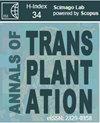磷脂酰乙醇(PEth)用于监测肝移植候选者的清醒度:酒精相关和非酒精相关肝硬化候选者差异的初步结果
IF 1.1
4区 医学
Q3 SURGERY
引用次数: 2
摘要
背景在德国,对患有酒精相关肝硬化的肝移植(LT)候选人进行清醒度监测是强制性的。上市前,必须禁欲6个月。然而,人们对酒精相关肝硬化的生物标志物表现知之甚少。尿(uEtG)或头发(hEtG)中乙基葡糖苷酸的常规检测容易操作,或在无尿中不可行。干血点中的磷脂酰乙醇(PEth)是一种很有前途的替代品。在我们的移植中心,我们将PEth与酒精相关和非酒精相关肝硬化的常规参数和自我报告进行了比较。材料/方法所有患者均接受自我报告问卷(AUDIT&TLFB)。在基线时抽取血液、尿液和头发样本,以及PEth干血点。此外,还进行了生存率分析。结果66例患者中,53例为LT患者,13例为迄今未列出的候选患者。在25名患者中发现了酒精使用障碍。uEtG、hEtG和PEth的阳性结果分别在5/65、9/65和34/66例中发现。在52%的酒精相关肝硬化患者中发现PEth阳性,而在53%的其他肝病患者中发现阳性。uEtG、hEtG和TLFB与较高的PEth值相关,而活动等待列表状态与负PEth值显著相关。在平均41.15个月的随访中,23名患者接受了移植(34.9%)。没有任何生物标志物能显著预测生存率。结论PEth具有较高的有效性和客观性,有助于LT患者的禁欲监测。在非酒精性肝病队列中,饮酒患者的比例很高,这突出了测试所有移植候选者的重要性。本文章由计算机程序翻译,如有差异,请以英文原文为准。
Phosphatidylethanol (PEth) for Monitoring Sobriety in Liver Transplant Candidates: Preliminary Results of Differences Between Alcohol-Related and Non-Alcohol-Related Cirrhosis Candidates
Background Monitoring sobriety is mandatory for liver transplant (LT) candidates with alcohol-related cirrhosis in Germany. Prior to listing, abstinence of 6 months is required. However, little is known about biomarker performance in alcohol-related cirrhosis. Routine testing of ethyl glucuronide in urine (uEtG) or hair (hEtG) is prone to manipulation or is unfeasible in anuria. Phosphatidylethanol (PEth) in dried-blood spots is a promising alternative. We compared PEth with routine parameters and self-reports in alcohol-related and non-alcohol-related cirrhosis at our transplant center. Material/Methods All patients received self-report questionnaires (AUDIT & TLFB). Blood, urine and hair samples, as well as PEth dried-blood spots were drawn at baseline. In addition, survival analyses were conducted. Results Out of 66 patients, 53 were listed for LT and 13 were candidates not listed so far. An alcohol-use disorder was found in 25 patients. Positive results for uEtG, hEtG, and PEth were found in 5/65, 9/65, and 34/66 cases, respectively. PEth positivity was found in 52% of patients with alcohol-related cirrhosis, while 53% of patients with other liver diseases were positive. While uEtG, hEtG, and TLFB correlated with higher PEth values, active waiting list status was significantly correlated with negative PEth values. During the mean follow-up of 41.15 months, 23 patients were transplanted (34.9%). None of the biomarkers significantly predicted survival. Conclusions PEth can importantly assist abstinence monitoring in LT candidates due to its high validity and objectivity. The high percentage of patients with alcohol consumption in the non-alcoholic liver disease cohort underscores the importance of testing all transplant candidates.
求助全文
通过发布文献求助,成功后即可免费获取论文全文。
去求助
来源期刊
CiteScore
2.50
自引率
0.00%
发文量
79
审稿时长
>12 weeks
期刊介绍:
Annals of Transplantation is one of the fast-developing journals open to all scientists and fields of transplant medicine and related research. The journal is published quarterly and provides extensive coverage of the most important advances in transplantation.
Using an electronic on-line submission and peer review tracking system, Annals of Transplantation is committed to rapid review and publication. The average time to first decision is around 3-4 weeks. Time to publication of accepted manuscripts continues to be shortened, with the Editorial team committed to a goal of 3 months from acceptance to publication.
Expert reseachers and clinicians from around the world contribute original Articles, Review Papers, Case Reports and Special Reports in every pertinent specialty, providing a lot of arguments for discussion of exciting developments and controversies in the field.

 求助内容:
求助内容: 应助结果提醒方式:
应助结果提醒方式:


